
Strength training isn’t just about getting stronger. Being able to conjure bigger, better feats from your muscles is impressive; but it’s so much more than that. Strength training is also about becoming confident, happier, healthier, and injury-free. Being stronger and fitter than before is just a bonus – albeit an incredible one.
What is strength training?
Strength training isn’t a gimmick – it’s exactly what you’d expect. The name says it all; you are literally training to become stronger, by putting a demand to adapt on your body.
Strength training can be summarized into two things:
- Moving your body against resistance
- Consistently increasing resistance to facilitate adaptations
So, technically, standing up right now and performing a body squat is strength training. Strapping a barbell to your back next week is strength training too, because you’re increasing demands.
It’s less about equipment and more about the science. Are you doing something to challenge your muscles and encourage them to grow stronger? If so, you’re strength training.
Why strength training?
The real question to ask yourself is; why not? This isn’t a sales pitch, we’re being serious. You’re reading this with some knowledge of the benefits of strength training, yet, there are not many reasons why you shouldn’t do it.
Strength training can:
- Improve confidence
- Make you healthier[1]
- Give you stronger bones[2]
- Support mental health[3]
- Fight disease
- Keep you lean (improve metabolism)[4][5][6]
- Prevent injuries[7]
- Help you live longer[8]
Research suggests strength training could improve the quality of life for many people facing medical conditions.
When planned properly, strength exercises could benefit; fibromyalgia[9], Parkinson’s Disease[10], clinical depression[11], osteoporosis[12], arthritis[13], Down Syndrome[14], lymphedema[15], and cancer survivors[16].
Unless you have a medical condition or injury that will make strength training unsafe, do it. You’re never too old to start and with the correct guidance, even children can strength train too. All it takes is a touch of careful planning and respect for your limitations.
Do I need specific equipment for strength training?
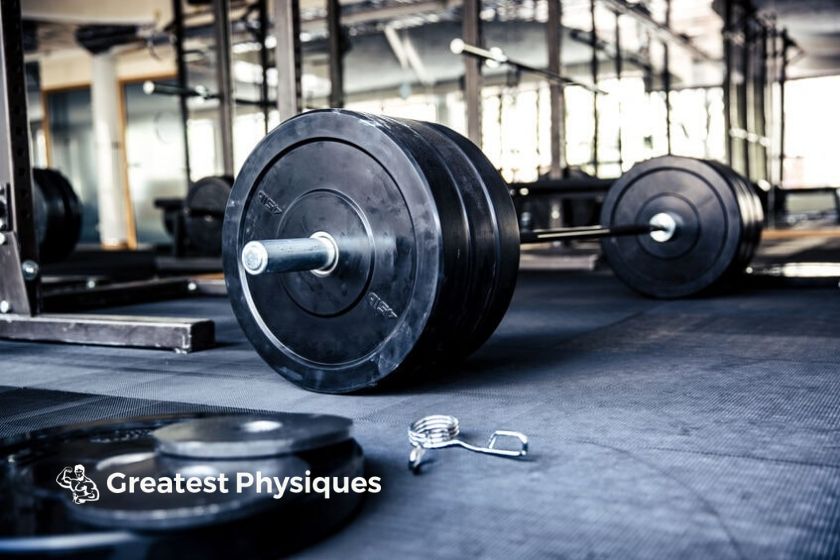
One of the biggest myths surrounding strength training is you need hordes of specific equipment. Sure, having free run of a fully equipped professional-strength studio is great, but it’s not the norm.
Most people who strength train start out with the most basic equipment there is – themselves.
You could start training right now if you chose. After a quick warm-up, you could drop into a set of pushups followed by squats then lunges to perform a short workout. After all, you’re pushing against gravity, which is the creator of all resistance exercises.
Once you’ve mastered bodyweight exercises, you’ll probably be excited to progress to training with added resistance. This might be in the form of machines, free weights, or other aides like rubber resistance bands.
Have you already racked up some mileage on your gym membership? Yes? Well, you’ll know there’s a clear separation between the free weights and machine sections. Some gyms have a literal line, and to be fair, not everybody likes stepping onto the other side.
Machines vs free weights
Machines often isolate a single muscle group and hold you in position. As a result, you may be less likely to injury yourself, which is why some people prefer them. However, on the other hand, free weights offer a greater range of motion and more versatility.
You could technically complete a full-body workout in 20-minutes with just one dumbbell. A single machine on the other hand, not so much.
Your best bet is to hire a trainer to show you how to use both. We recommend progressing to free weights over isolation exercises for their versatility.
Your supporting muscles are less likely to be neglected, you’ll have an easier time hitting compound movements (we’ll explain later), and you can complete multiple exercises with one piece of equipment.
How to start strength training?
Starting strength training doesn’t need to be complicated. So, we’ll keep your introduction simple, so you can get started right away.
Here’s how to start:
- Find a place to exercises – a gym is ideal but not essential
- Wear comfortable clothes you can move around in – think stereotypical sportswear, avoid excessive zips and sharp accessories
- Hire a trainer – call on a professional or an experienced friend to show you the ropes
- Determine current fitness level – exercise according to where you’re at right now. You’ll be able to step up the intensity once you’re ready
- Don’t wait to lose weight – strength training is a great tool to burn body fat
You don’t need a gym membership to start strength training. But, committing to one can help your goals in the long run. You’ll have more equipment to use, easier access to trainers, and you’re likelier to stick to your new stronger way of living if you’ve paid for it.
Money can be a good motivator when starting out.
We also advise paying a one-off fee for a personal trainer to show you the ropes. While this isn’t an essential step, it can increase confidence and awareness in the gym. Alternatively, call on a trusted friend well-versed in the art of strength training to help.
The steps
Your first step is to determine your current fitness levels. Don’t worry, we’re not asking you to put yourself through a US Marine selection course.
Simply ask yourself if you could perform a bodyweight squat, push up, crunch, and lunge safely. If not, your first step will be working toward these, with an overall goal of completing ten of each movement unbroken.
Concentrate on completing each rep with perfect form and embrace this as an ego-less time to learn.
After that, progress to training with weights. Isolation machines are a great place to start if you’re brand new to strength training, but we suggest moving onto the free weights when you’re comfortable. It’s worth the cash to hire a personal trainer to teach you the basics.
Maybe you’re reading this thinking, “okay, but I need to lose weight first!” Well, we’ll let you into a secret – start anyway. Strength training is one of the best forms of exercise to scorch body fat according to studies[17][18][19].
By building more muscle, you’ll simultaneously speed up your metabolism.
This means you’ll burn a greater number of calories per day, even at rest. Why wait to lose weight to start strength training? Begin now and let lifting help you achieve your body composition goals.
Choosing your exercise
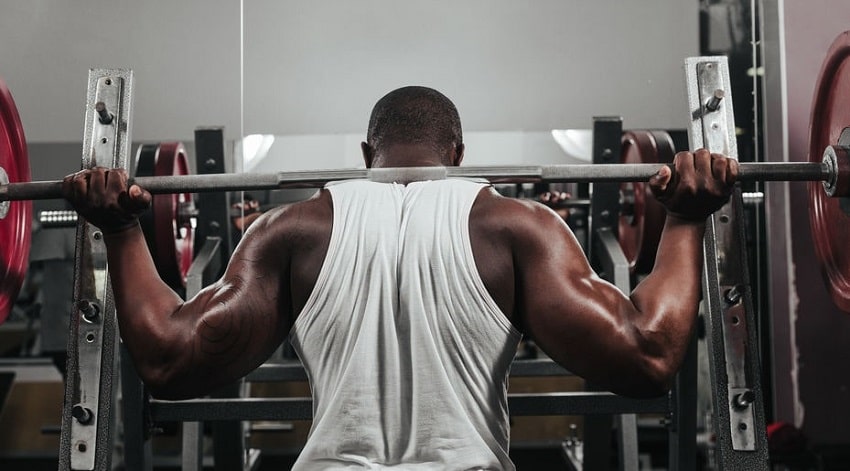
Choosing the right kind of exercise is important for progression. A plan of action is always the most efficient route to success, and as they say; fail to prepare – prepare to fail.
First, it’s important to pick exercises suitable to your level of preparedness. Being smart and respecting your abilities should keep you safe and working out for years to come.
It’s all about pushing yourself to progress, without compromising safety. So, start with bodyweight, before progressing to weightlifting or resistance bands.
Next, it’s time to go from macro to micro. There are 264 individual muscles sat primed and ready in your body right now. They work in opposing pairs too, with one or more relaxing, while others contract.
Choosing the right exercise for the muscle group you want to target is important for building a well-balanced workout routine.
It’s recommended you train each muscle group twice a week minimum[20][21]. You’ll experience two or more muscle protein synthesis spikes every seven days, which benefits your progress. Compound exercises can help here.
Isolation vs compound exercises – which is better?
- Compound exercises are exactly what their name suggests – a movement performed using multiple muscle groups. You are literally compounding a bunch of muscles into one exercise.
- Isolation exercises, on the other hand, call upon single muscle groups – hence its isolate name tag. When you’re only using one joint, you’re using an isolation exercise.
Compound exercises should make up the bulk of your workout. They allow you to use multiple muscle groups, which makes them more efficient, and transferrable to everyday life.
We call this style of exercises functional strength training. After all, you’re more likely to pick up a box from the floor rather than bicep curl a jug of milk.
Studies show that multiple full-body workouts are better for overall muscle building compared to stereotypical bodybuilding splits. Compound exercises make it easier to work the entire body in a single session with fewer sets.
Therefore, rather than go for an old-school body part split routine, we encourage you to go full body. You’ll also be able to get that double or triple MPS hit we mentioned earlier by exercising an area more than once per week.
None of this means isolation exercises are redundant though. No, quite the opposite really. Isolation exercises are awesome for spot training certain areas. Maybe these places need extra attention, or, they require rehabbing after injury.
Use isolation exercises to focus on specific muscle groups at the end of a workout. Remember it’s important to train all four sides of your body equally to avoid muscular imbalances – a common cause of injury.
Sets, Reps and Weights
There are no hard and fast rules for how you work out. One of the best things about strength training is you can have complete control – there are no actual rules.
But there are guidelines. Exercise scientists and athletes alike have spent years discovering the ideal way to strength train. Through science and a heavy dose of trial and error, they have established a handful of guidelines. Fortunately, a handful apply for new starters.
It’s suggested you complete around 10 to 20 sets per muscle group per week. Therefore, if you used four sets per muscle group each workout, you might only need to hit the gym three out of seven days.
Pick four to six exercises for each workout and you’re set for an effective full-body workout.
Reps can also vary greatly. To make it easier to choose, it’s a good idea to learn which rep-range suits certain goals:
- Myofibrillar hypertrophy (strength): 1-5 reps with heavier weight
- Sarcoplasmic hypertrophy (size): 8-12 reps with lighter weight
- Muscular endurance/cardiovascular conditioning: 12-15+ reps with lighter weight
Okay, so what weight do you use? Choose a weight that allows you to complete the desired rep range with perfect form. We’re not looking to break any world records here, so technique is the most important part of your training.
Once your usual rep range becomes easy, step up the weight in small increments. It’s suggested you use increments under 10% for safety.
Long term consistency always trumps short term intensity – play it smart with small victories each week. They’ll add up before you know it.
Strength training styles for beginners
Bodyweight training
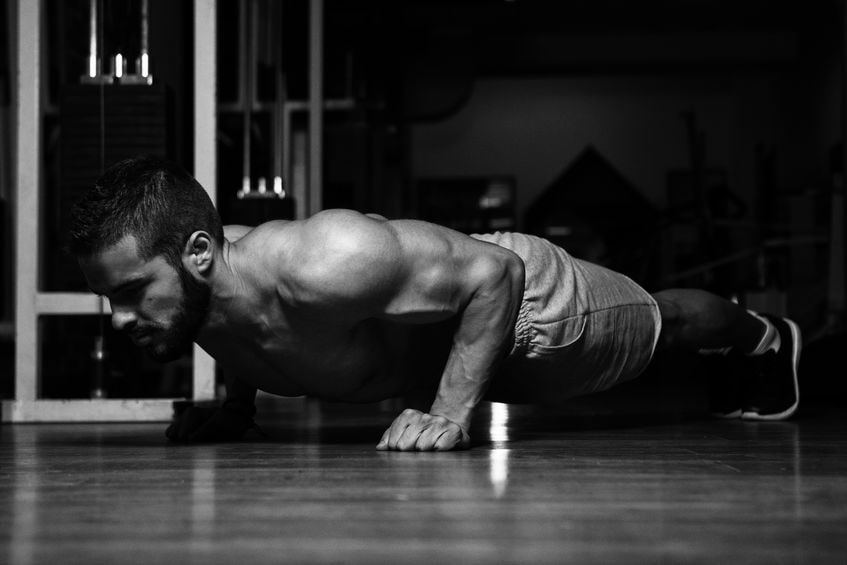
Bodyweight training – aka calisthenics – is the most primal, humankind of exercise there is. You literally have nothing but yourself and gravity to take your physique to the next level. Plus, because you’re not handling any weight, it could be considered the safest option.
There’s a myth that bodyweight training can’t make you strong – don’t believe it. We’d tell any doubters to head straight to YouTube and see some of the amazing feats carried out by calisthenic stars across the globe.
Bodyweight training can take you far, but it’s also perfect for people starting strength training.
Best bodyweight exercises for beginners:
- Bodyweight squat
- Pushup / wall pushup
- Crunch
- Plank
- Pushup
- Lunge
Note: You can do all these quite easily at home. No need to buy a gym membership just yet – unless you want to.
Barbell training
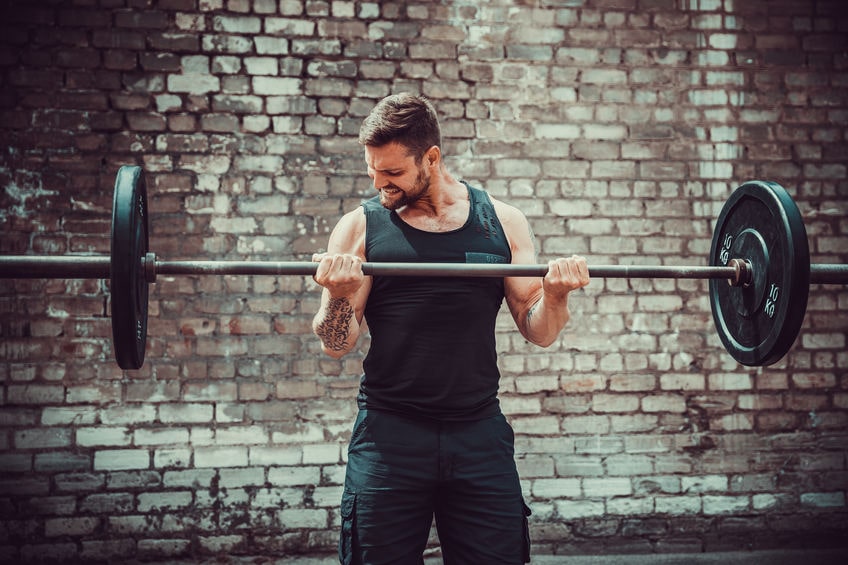
Beginners sometimes find barbells intimidating. Learn how to use them though, and both your body and confidence can grow quickly. Barbells are incredibly versatile and allow you to move unhindered through all four planes of motion.
Simply put, you can move up, down, forward, and backward with just one piece of kit. You also can load and lift greater amounts of weight strapped to each end of the bar.
Greater load = greater muscle fiber recruitment and tension too. You don’t have to start out by lifting heavy though, go at your own pace.
Bottom line – learn how to use a barbell from a high-quality trainer. It’s worth the money you spend to lift safely and injury-free.
Best barbell exercises for beginners:
- Bench press
- Push press
- Bent over row
- Romanian deadlift
- Front squat
Dumbbell training
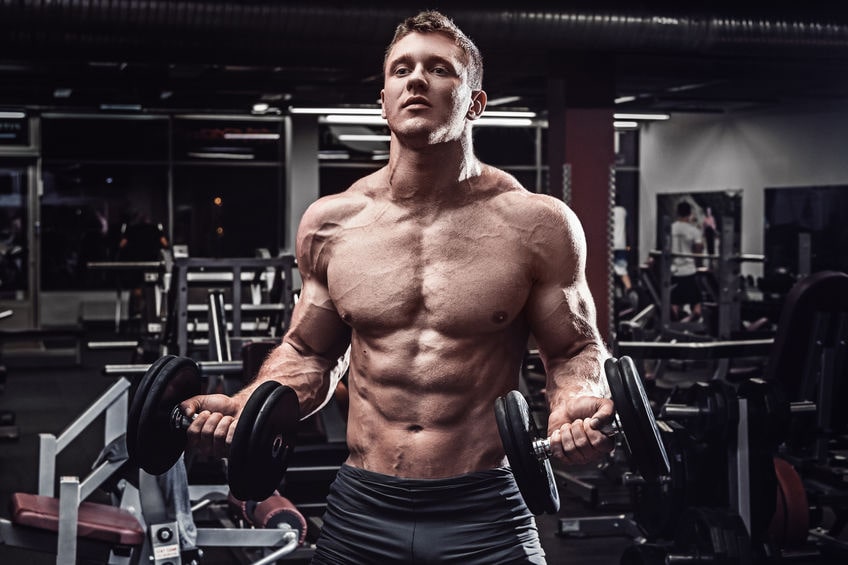
Dumbbells are like miniature barbells you can hold in each hand. So, it should come as no surprise that most of the benefits cross over. Supporting muscles (core included) all get attention, you can move in each plane of motion, and a full-body workout is yours with just one piece of equipment.
But, there’s more. Dumbbells make it easier to work unilaterally, which is when one side works independently on its own. This means there’ll be no opportunity for your strong side to take over.
If you want to ensure you’re building a balanced body, dumbbells are right up there as your go-to method.
Beginner’s are also fans of dumbbells because they’re often lighter. They can be a great confidence builder when transitioning from bodyweight to barbell.
Best dumbbell exercises for beginners:
- Chest press
- Bent over row
- Triceps extensions
- Bicep curl
- Shoulder press
- Goblet squat
- Lunges
Kettlebell training
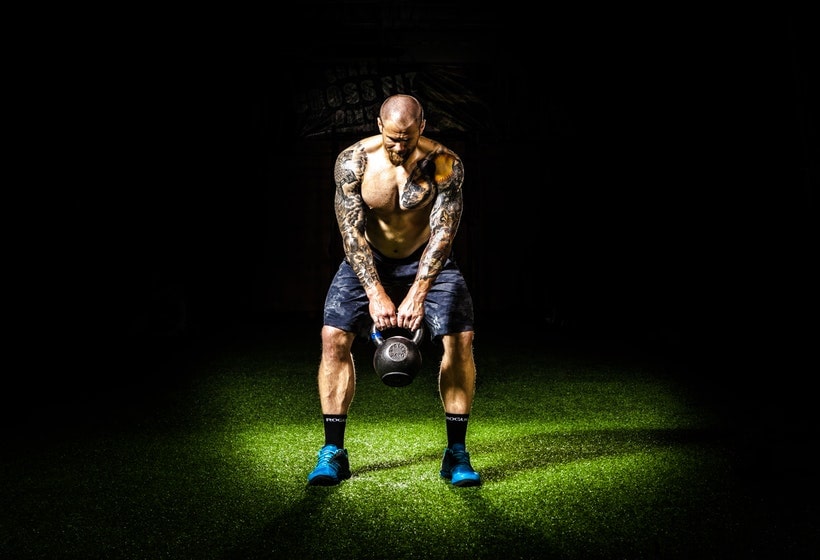
Kettlebell training is all the rage right now – for good reason too. They’re essentially a weight with a handle that can be pulled, swung, and pressed in a heartbeat. Many kettlebell users love how versatile and flowing they can become.
Interestingly, kettlebells made their mark the most in the USSR, where they became an indispensable training tool for athletes. You’re required to use a great degree of coordination and stabilization when using a kettlebell, which transfers effortlessly into developing your functional fitness.
We recommend hiring a trainer to show you the kettlebell ropes. While using a lightweight is relatively safe for beginners, learning the proper movement patterns can make you more efficient, while also preventing injury.
Once you’ve mastered the swing you can start to have fun with the snatch, clean, and more.
Best kettlebell exercises for beginners:
- Swing
- Deadlift
- Goblet squat
- Single-arm swing
- Press
- Farmer walks
Machine training

Machine training can seem like a comfortable way to start strength training. They’re often safer for beginners than free weights and seem easier to use.
Even though barbells are becoming increasingly popular, many gym-goers still gravitate toward machines. They hold you in position, which can make exercises safer, and you can change the load easily in small increments. A machine might seem simpler to get your head around too.
Most machines are designed to isolate muscle groups. One might work your hamstrings, another your lateral pectorals. Some in the case of the leg press and hack squat can target multiple muscle groups.
Although standard machines aren’t the most versatile piece of kit, it can be a great place to begin your journey to strong.
Best machine exercises for beginners:
- Leg extensions
- Hamstring curls
- Cable triceps pushdown
- Cable biceps curl
- Leg press
- Seated row
- Lat pulldown
The final word
Strength training is no longer a domain for muscle building men in their 20s. It’s now a global phenomenon, with everybody from athletes, to the oldest generation taking part.
Every day people are finally learning the benefits of lifting and seeing it transform their health, body, and confidence. You can start today too – right here, right now.
Follow the steps outline above to begin your journey to strong.
If you enjoyed reading that you might also like:
References
[1] https://www.researchgate.net/publication/280034904_Resistance_exercise_is_medicine_Strength_training_in_health_promotion_and_rehabilitation
[2] https://www.ncbi.nlm.nih.gov/pmc/articles/PMC6279907/
[3] https://www.ncbi.nlm.nih.gov/pubmed/25789738
[4] https://www.ncbi.nlm.nih.gov/pubmed/11283427
[5] https://www.ncbi.nlm.nih.gov/pubmed/3337037
[6] https://www.ncbi.nlm.nih.gov/pubmed/9309627
[7] https://bjsm.bmj.com/content/52/24/1557
[8] https://www.health.harvard.edu/staying-healthy/want-to-live-longer-and-better-strength-train
[9] https://ard.bmj.com/content/60/1/21.short
[10] https://www.news-medical.net/news/20120217/Long-term-weight-training-may-benefit-Parkinsons-disease-patients.aspx
[11] https://psycnet.apa.org/record/1989-26142-001
[12] https://www.naturalnews.com/010528_bone_density_mineral.html
[13] https://www.arthritis.org/living-with-arthritis/
[14] https://minds.wisconsin.edu/handle/1793/22059
[15] https://www.nejm.org/doi/full/10.1056/NEJMoa0810118
[16] https://www.tandfonline.com/doi/full/10.1080/02841860701418838
[17] http://www.tandfonline.com/doi/abs/10.1080/02701367.2014.999190?journalCode=urqe20
[18] https://link.springer.com/article/10.1007%2Fs00421-001-0568-y?LI=true
[19] http://www.tandfonline.com/doi/abs/10.1080/07315724.1997.10718664?src=recsys
[20] https://www.ncbi.nlm.nih.gov/pubmed/27102172
[21] https://www.researchgate.net/publication/326055694_High_Resistance-Training_Frequency_Enhances_Muscle_Thickness_in_Resistance-Trained_Men



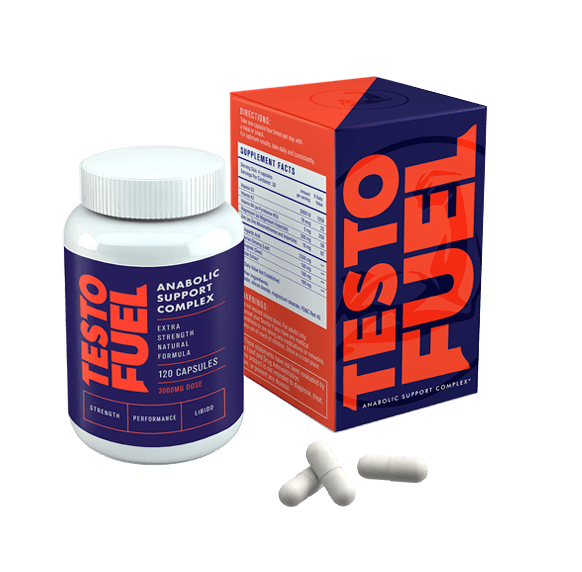
Leave a comment